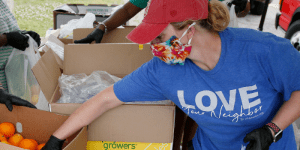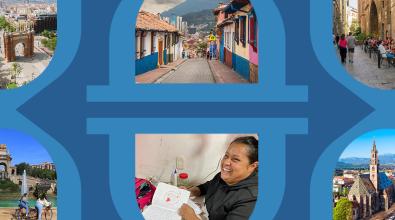Food fixes: How cities can help ensure residents don’t go hungry

For local leaders, ensuring food access is one of the most vexing, cross-cutting issues of the COVID-19 crisis.
Demand at food banks is surging with the rise in unemployment, even as volunteers needed to staff them stay home. The schools and senior centers where food usually gets distributed to vulnerable residents have closed. Meanwhile, public health experts say getting food into the hands of people who are sick and isolating at home — or have been exposed to the virus and are in quarantine for 14 days — is essential to getting spread of COVID-19 under control.
San Francisco Mayor London Breed and her team have put together one of the most extensive responses anywhere. They’ve delivered more than 70,000 meals or groceries via a suite of new programs over the past few weeks, and that’s on top of existing programs that serve more than 22,000 people annually.
Mary Ellen Carroll, executive director of the city’s Department of Emergency Management, said the city’s goals have been to establish easy-to-access food resources for a whole array of residents — seniors, the homeless, the newly food insecure. Carroll said a key was simplicity; most of the services are available through a single web page or a phone call to the city’s 3–1–1 system.
“This is an area, a focus on vulnerable populations, that we’ve been thinking about for some time,” said Carroll, noting that the Bay Area’s high risk of earthquakes led to extensive planning for food needs in emergencies long before the pandemic struck. “It’s obviously something we knew, but we’ve focused on it in a lot more detail and we’re very proud of the work we’ve done.”
A key feature of the city’s multi-pronged response is that people who have tested positive or been exposed to the coronavirus and can’t leave home can get food support during their time in isolation or quarantine. All it takes is a referral from a doctor and a call to 311, where a social worker assesses the person’s need and connects them with grocery delivery from the San Francisco-Marin Food Bank. Prepared meals are available for those who can’t cook at home.
Other key elements of San Francisco’s approach include creating 30 pop-up pantry sites in partnership with the San Francisco-Marin Food Bank; the sites are staffed with dozens of librarians who work in two-week-on, two-week-off cycles. For residents experiencing homelessness, there’s a new program providing up to 700 meals a day at 44 locations throughout the city. And existing services to serve communal meals at senior centers and other facilities have been strengthened and, in many cases, transitioned from sit-down services to takeaway offerings that are handed out or delivered.
Funding for these emergency food programs comes in part from tax-deductible contributions made to the city’s Give2SF relief fund.
Cities across the country are also taking ambitious steps to address food insecurity. Other approaches being implemented by other cities include:
- In Anchorage, Alaska, sidelined school bus drivers are being used to deliver groceries to hungry kids.
- Detroit has developed an interactive map that helps residents find food pantries and other free food resources in Detroit. The map includes updated information on type of food, eligibility criteria, and opening times for all 54 food distribution sites in the city.
- In Seattle, about 1,000 people will receive $800 grocery vouchers as part of an effort by the city to provide more relief to workers who have lost their jobs and incomes.
- In New York City, where Bloomberg Philanthropies has partnered with World Central Kitchen to provide daily meals to 30,000 healthcare workers, the city has committed to spend $170 million in the coming months to ensure no New Yorkers go hungry because of coronavirus or the economic fallout from the pandemic. The new funding includes $50 million for an “emergency food reserve” that will have 18 million meals ready to go when needed.
Find more information on these food-related city actions on Bloomberg Philanthropies COVID-19 Local Action Tracker. For more ideas on local approaches to food access, join Cities of Service for a webinar on Tuesday, May 12 at 12 p.m. EDT. Register here.


